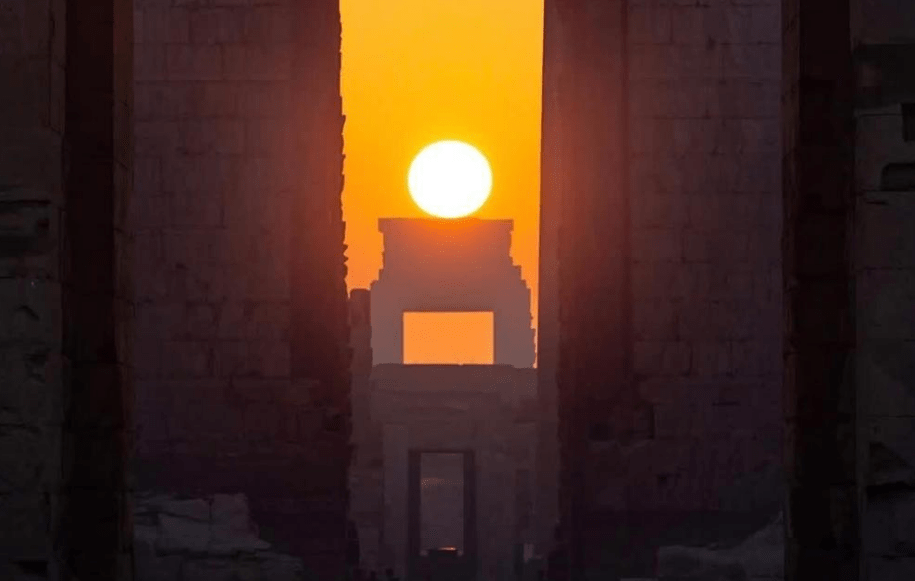By Malak Khaled
On Saturday, December 21, 2024, the normally shadowed sanctum of Karnak Temple in Luxor was bathed in sunlight, as the rays aligned perfectly with the temple’s main axis. This rare astronomical event marks the winter and summer solstices every year.
As the sun aligned seamlessly at the Karnak Temple, illuminating every inch, people were left in awe of this phenomenon. Symbolizing renewal and rebirth, this annual scene connects Egypt’s ancient beliefs, its impressive architecture, and the cosmos.
Historical and Cultural Context
The sun alignment at Karnak Temple is significant in ancient Egyptian culture. It marks the winter solstice, when the sun, after its longest absence, was believed to be “reborn.” Ancient Egyptians saw this as the return of Ra, the sun god, who symbolized life, death, and rebirth.
This event also signified the beginning of the agricultural season, when the Nile floodwaters receded, and crops began to grow again. It was a time to honor the gods for their role in sustaining the land and its people.
The Myth Behind the Sun’s Rebirth
Beyond the astronomical spectacle, the alignment at Karnak Temple has deep mythological significance. In Egyptian mythology, Ra’s journey across the sky represented the cycle of life, death, and rebirth.
The story goes that humans were born from the tears of Ra, the sun God. In a moment of rebellion, humans revolted against him. Ra decided to punish them and stopped living among them.
He started journeying each day to the Underground for 12 hours, illuminating the dead instead. And this is how morning and night came to be.
His trip to the underground at night symbolized the end of his life, and his return at dawn marked a resurrection, embodying life’s continuous renewal.
This daily journey of Ra is why the sun alignment at Karnak Temple is so important. It symbolizes the restoration of order, the balance between life and death, and the importance of the sun as a source of energy and life.
When Does the Sun Align at Karnak?
The sun alignment at Karnak happens twice a year, during the summer and winter solstices. The summer solstice takes place around June 21, while the winter solstice falls on December 21. These solstices are significant moments when the sun reaches its furthest point from the equator, leading to the longest and shortest days of the year.
Why Does This Phenomenon Happen at Karnak?
The alignment at Karnak Temple wasn’t a coincidence. The Temple of Amun-Ra at Karnak underwent more than 1,500 years of construction, destruction, renovation, and expansion. Alongside the Pyramids, it ranks as one of Egypt’s most remarkable sites and, by some estimates, is the largest religious structure ever built.
It was intentionally designed by the ancient architects and priests who built the temple. They aligned the structure so that on key days like the solstices, sunlight would enter the temple in a precise and meaningful way.
This careful design reflects the advanced understanding of astronomy and their belief that the gods, particularly Amun Ra, were present during these celestial moments. The Karnak was seen as a place where the divine and earthly worlds met, with the sun’s rays serving as a powerful symbol of the gods’ ongoing presence.
Why Is This Phenomenon So Special?
The sun alignment at Karnak Temple continues to fascinate people worldwide. It is a remarkable testament to ancient Egypt’s deep knowledge of astronomy and its fusion with religious and architectural practices.
Each year, thousands of visitors come to witness this extraordinary event, drawn by its cultural and spiritual significance. The alignment is not only a fascinating display but also a reminder of the ancient Egyptians’ unparalleled legacy.
As locals and visitors gather in front of the Karnak Temple each year to gaze upon this phenomenon, the sunlight filters through the temple, and its warmth connects the people of today with the ancient Egyptians.
The alignment of the sun at the Karnak Temple will continue to captivate and remind us of their incredible knowledge. It’s a moment that reflects the heritage of the ancient Egyptians and their ability to blend science with spirituality.
WE ALSO SAID: Don’t Miss…Wasabi Isn’t Just for Sushi: Discover Its Ancient Papyrus Preservation Power



